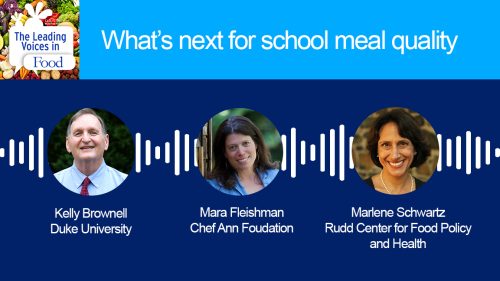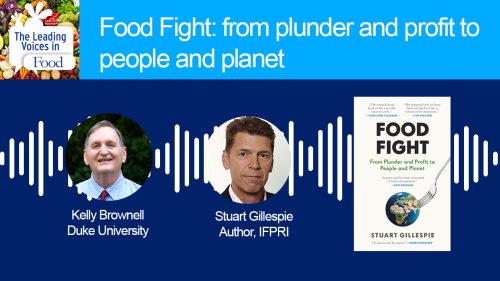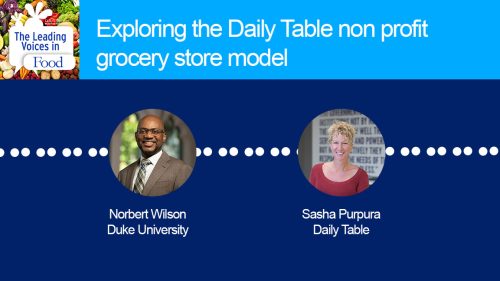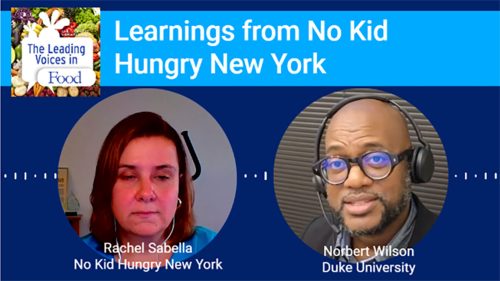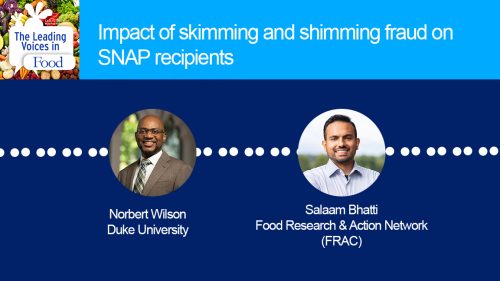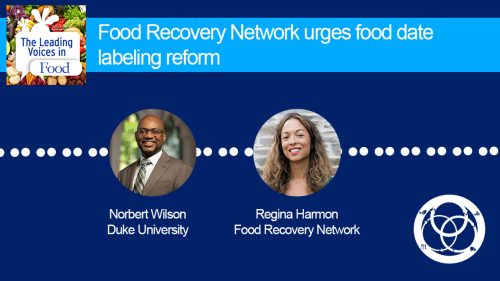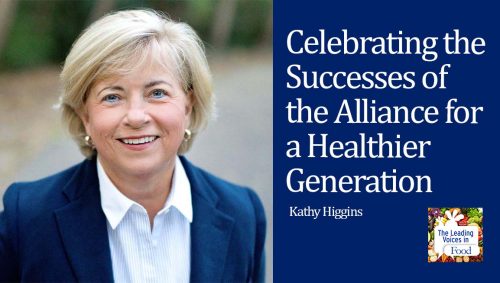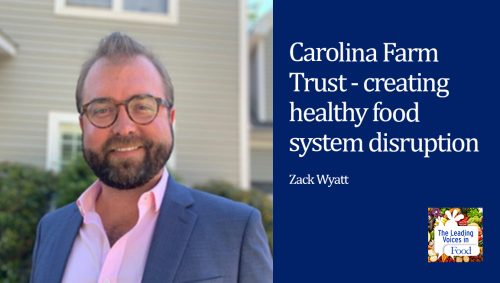The Leading Voices in Food
E239: National report – where the grocery stores are missing
Today we’re talking about who has access to full-service supermarkets in America’s cities, suburbs, small towns and rural communities. According to The Reinvestment Fund’s “2023 Limited Supermarket Access Analysis Report,” 8.5% of people in the US live in areas with limited access to full-service supermarkets. This means that families must travel further to get fresh foods, and it creates a barrier to adequate nutrition. This is the 10th year The Reinvestment Fund has published the “Supermarket Access Report,” which provides data and context about grocery store access across the country. Here to discuss the latest figures is policy and analyst Michael Norton.
Subscribe: Apple Podcasts | TuneIN | YouTube Music | SoundCloud | PocketCasts | Radio Public
Tags: Community & Economic Development | Equity, Race & Food Justice | Food Insecurity | Philanthropy & Food Systems |

Michael Norton, Ph.D., serves as Chief Policy Analyst at Reinvestment Fund, and supports all research related to Reinvestment Fund’s organizational goals and mission. In this role Dr. Norton works closely with a range partners, including small non-profit organizations, local and national philanthropies, private companies, colleges and universities, school districts, federal, state, and city governments and agencies. His work leverages nearly a decade of experience as researcher and project director to develop data driven solutions – solutions that meet the unique needs of Reinvestment Fund and our key stakeholders in the public and private sectors. Dr. Norton completed his doctoral studies in the Sociology Department at Temple University, where his research examined the relationship between secondary mortgage market activity and neighborhood change in the Philadelphia region at the turn of the 21st century. Prior to joining Reinvestment Fund in 2015, Dr. Norton served as a Senior Research Associate at Research for Action in Philadelphia. In this role, he led and co-led a range of mixed-methods evaluations of educational reform initiatives and policies at the local and state levels.
Interview Summary
This is a really interesting and kind of nuanced topic, so I’m happy we can talk about it in some detail. Why don’t we just start off with kind of a broad question. What do we know now about areas of limited supermarket access in the US?
Kelly, I think the big thing to take away at the very beginning is that the share of people living in places that would be considered low access is roughly the same as it’s been over the past 10 years. We have about 8.5% of the population living in low-access areas across the country. That’s pretty consistent to what it’s been for over a decade. But what’s important is that how low-access areas are distributed across the country varies quite a bit. And where they exist, the density of the populations where they exist, really informs the kinds of interventions that are available for addressing these needs. These vary considerably in different parts of the country and at different geographic scales. And what I mean by that is suburban areas, rural areas, and then some of the most remote areas across the country. So we do have a sort of consistent number or share of people. The actual number has gone up a little bit because the population has continued to increase. They become distributed in different ways that follow different kinds of development patterns, on the one hand. But then also places where you end up getting patterns of residential and racial segregation in more developed parts of the country.
It’s so interesting. So, given that the average has stayed essentially the same over the 10 years you’ve been doing the reports, have there been pressures pulling in either direction that might have changed over the years? So, for example, are there pressures that are making access to full-service supermarkets less likely? Are they pulling out of some places, for example? And might that offset by some positive developments in other areas? So, while the average stays the same, the contours look different?
I think the way to think about that is that we see a lot of expansion of low-access areas in the big metro areas that are expanding the fastest. So, the biggest increases in populations living with limited access are in big state in the South and out west in places like Arizona, Nevada, Texas, where you have these large metros that are growing at a really rapid rate. And the reason for that is that oftentimes residential development will show up before commercial development. So, in those kinds of places, food retail is trailing behind residential development. And probably those places are going to be well served by the time we update this analysis again in four or five years because of what those development patterns look like, right? So, when you’re building more houses in more urban and remote areas, there’s still folks who are first in buying out in those places. They’re still going to have to go a long way to get their groceries for a few years until supermarket identifies this as a place where there’s going to be enough demand for us to put one of our Krogers or Targets or Walmarts or what have you. But we’ve also seen, and this is more common in urban places, is the expansion of these low-access areas that have smaller populations, right? And so these are places with between 1,000 and 5,000 residents where folks are still having to go disproportionately far to get access to a full-service grocery store. Sometimes this is because stores have pulled out in these places because of limited demand, historically. And that limited demand is mostly because folks don’t have as much income to spend on their groceries, right? And we see these little areas popping up within metro areas and even in some close-in suburbs and places across the country. And so you have sort of these bigger LSA areas, which have at least 5,000 residents on the outer edges of a lot of metros and in some within the cities, but mostly within the cities. It’s these smaller, limited access, low population areas. And this differentiation of the type of low-access area is something that we introduced in this update to our analysis that previously wasn’t available. It provided a really nice nuance to understanding what limited access to supermarkets looks like going forward, both within urban places, suburban places, and in some of these really remote parts of the country.
So, based on this research, what does it tell us about the future of insecurity in the United States?
I think what it really tells us is that it depends on where you live and what kind of community you live in and what that’s going to look like. I think the ability to provide a little bit more nuance around who has access and when they have limited access, what about their community is going to inform the response to ensuring that folks are able to get what they need. In places where they are these traditional sorts of limited supermarket access areas where you have at least 5,000 people, they can become pretty good candidates for operating a full-service store, right? But when you think about urban parts of the country where you’ve had central business districts or neighborhoods sort of hollowing out in different places and local supermarket is closed, but there aren’t enough people there living to support a full-service store, different kinds of interventions are required, right? And then in these really remote parts of the country where you don’t have very many residents, but you have at least a thousand, but people are living a long way away from each other, how do you serve those places? Because some of them, these are very small towns, right? And there are people who have been living there and if the grocery store closed, then they have to drive 35-40 miles to the next town, right? That becomes a real challenge for their general way of life. I think really thinking about the future of food access and food insecurity in this country really has to have a geographic nuance to it in thinking about the appropriate responses that are going to meet the needs of people living in different parts of the country.
So, how does your study inform investments do address food insecurity?
Reinvestment Fund has a very active retail portfolio, both on our lending side, and Reinvestment Fund is also the national fund manager for USDA’s Healthy Food Finance Initiative. These two avenues through which we make loans to increase access to fresh food and through USDA’s HFFI program are opportunities to innovate. The USDA’s Healthy Food Finance Initiative is both a grant-making and a lending program that is designed to identify innovative responses to access to fresh food in these different types of areas. So, we’re able to use the results of these analyses to identify places where you can align the kinds of programs that people are proposing. Whether that’s a small format store in a city where their primary supermarket has closed, whether it’s a mobile market that is serving folks who live very far distances from their nearest food retailer, or whether it’s setting up a aggregation site that is not just food retail but sometimes is attached to a healthcare center or a hospital where people are also making regular trips. These become opportunities for us to support innovative approaches and also try out different things. Once you start to get some information from successful programs that are coming out of the grant program, as they become investible and scalable at a store level when you become ready to take on debt to expand your operation or open a store in a place that typical operators aren’t willing to go.
So, let me ask you a question about the Healthy Food Financing Initiative. With politics being so partisan these days, is this a partisan issue as well, or is there bipartisan support for things like this?
This is the good news part of access to fresh food. It really is a bipartisan issue. Healthy Food Finance Initiative was created under the Obama Administration, was expanded under the Trump Administration and has been expanded even more under the Biden Administration. Each subsequent farm bill has expanded the capital available for the Healthy Food Finance Initiative, with the goal to try and figure out how do we meet the food access needs of everybody in this country in a way that provides a signal to private market operators that they can be successful in these places.
That really is a bit of good news, and I’m really happy to hear that. But I also wanted to ask you, are there options aside from full-service supermarkets to help address some of these matters you’re discussing?
Absolutely, absolutely. And these are things like smaller format stores, almost like a corner store but that operates like a healthy food market. And these are really appropriate in places where there are limited access, low population, and sort of filling in pockets inside urban communities and close-in suburbs. There are mobile market options that are popping up in different places. Food aggregation hubs that will be cited within the center of a low-access area where people can come to a central location and having purchased food online that shows up and then people can come and pick it up. There’s expanding delivery options to more remote parts of the country. So, there is a wide diversity of models that are proliferating beyond just bricks and mortar traditional grocery stores. It’s really the job of HFFI to seed these initiatives, identify the ones that are doing really well, and then work with the folks who created them and then others to scale them down the road into places that are not served by food retailers.
I think you’ve helped answer the next question I was going to ask, which is how does this research help policy makers and practitioners think about addressing food insecurity in their community? There’s a fair amount of tailoring that could go on where you’re trying to meet the needs of a specific community.
That’s right. And I think one of the things that’s important to keep in mind is the role that financial institutions like Reinvestment Fund play in making this possible. So, Reinvestment Fund is a community development financial institution, which is best understood as like a nonprofit bank. And these exist across the country and are more or less active in different markets, but they’re really focused on working in a very deliberate, hands-on way with our borrowers to create access to fresh food in places where it’s not going to be easy, right? Because if it was easy, all the big food retailers would be there, right? So, we have to be patient. You have to find someone who’s willing to take a chance operating the store, to help them develop their business plan, help them identify all of the ins and outs that go with standing up a food retail business, and then work with them throughout the process of them sort of getting access to capital and making their business work. And that work is a lot more work than what is required to finance a new grocery store that is run by Target or run by Walmart, Krogers or something like that. This is a critical role that the CDFI industry is playing and increasingly recognized at the federal level as a resource for deploying public subsidies through the private market into the hands of operators who are going to make it work in places where traditional food retailers and capital just won’t go.
Let me ask a big-picture question. and this is a little complicated in my own mind. So, we’re sort of defaulting in a way to the idea that full-service supermarkets providing access to such things for more people is a good outcome. And from a social justice point of view, it’s unquestionably true that people who live in different sets of financial circumstances should still have access to things that people in better financial circumstances have. But in terms of nutritional outcome, having access to a full-service supermarket brings a lot more than just the healthy foods. And in today’s modern full-service supermarket, the highly processed, less healthy options must outnumber the healthy ones 10 to 1, 20 to 1, 50 to 1? I have no idea what the number is, but it’s enormous. And so, providing government support and financial incentives for a big store to come in is providing access to a lot more than healthy foods may have adverse nutritional outcomes rather than positive ones, unless you’re just sort of agnostic about the type of food that people are getting access to, that any food is better than nothing if you have food insecurity. But I wonder how one might address that. And whether one could think about providing resources that were structured differently to encourage smaller stores, for example, that focus on more healthy options and fewer of the less healthy ones. And then you might get the social justice part addressed at the same time you’re having a better nutritional outcome.
Kelly, that’s such a good question, and one that we wrangle with all the time. Because there is actually fairly limited evidence to suggest that access to fresh food is going to lead people to make healthier choices about what they consume. One of the sort of operating assumptions is that in the absence of access, you’re not going to make healthy choices. And once there is at least access, the possibility for making healthier choices increases from, zero to something, whatever it is that is going to be motivating individuals how they go about making choices for the foods that they consume. And it is a very tricky relationship that folks in the food industry grapple with all the time as well in the medical profession. I think from a grant-making standpoint and a financing standpoint, Reinvestment Fund’s position is always that whoever is receiving support through our programs or from our lending capital is offering a selection that meets what you would consider healthy food retail options, right? That there is an assortment of fresh fruits and vegetables, fresh produce, fresh meats and dairy, in that also with the understanding that almost all food retailers are also going to offer less healthy options. That is a constant tension within the field. And figuring out how to encourage behavioral change by consumers is sort of beyond the ability of HFFI to move. What we can do is ensure that the organizations and the individuals who we support are offering a variety of healthy options for the patrons that are coming into their locations.



